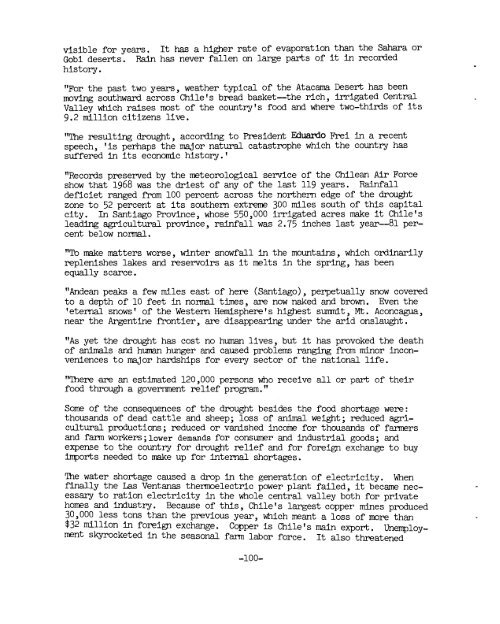3. - usaid
3. - usaid
3. - usaid
You also want an ePaper? Increase the reach of your titles
YUMPU automatically turns print PDFs into web optimized ePapers that Google loves.
visible for years. It has a higher rate of evaporation than the Sahara or<br />
Gobi deserts. Rain has never fallen on large parts of it in recorded<br />
history.<br />
"For the past two years, weather typical of the Atacama Desert has been<br />
moving southward across Chile's bread basket-the rich, irrigated Central<br />
Valley which raises most of the country's food and where two-thirds of its<br />
9.2 million citizens live.<br />
"The resulting drought, according to President Ehwd~ Frei in a recent<br />
speech, 'is perhaps the maJor natural catastrophe which the country has<br />
suffered in its economic history.'<br />
"Records preserved by the meteorological service of the Chilean Air Force<br />
show that 1968 was the driest of any of the last 119 years. Rainfall<br />
deficiet ranged from 100 percent across the northern edge of the drought<br />
zone to 52 percent at its southern extreme 300 miles south of this capital<br />
city. In Santiago Province, whose 550,000 irrigated acres make it Chile's<br />
leading agricultural province, rainfall was 2.75 inches last year--81 percent<br />
below normal.<br />
"To make matters worse, winter snowfall in the mountains, which ordinarily<br />
replenishes lakes and reservoirs as it melts in the spring, has been<br />
equally scarce.<br />
"Andean peaks a few miles east of here (Santiago), perpetually snow covered<br />
to a depth of 10 feet in normal times, are now naked and brown. Even the<br />
'eternal snows1 of the Western Hemisphere's highest sumit, Mt. Aconcagua,<br />
near the Argentine frontier, are disappearing under the arid onslaught.<br />
"As yet the drought has cost no human lives, but it has provoked the death<br />
of animals and human hunger and caused problems ranging from minor inconveniences<br />
to major hardships for every sector of the national life.<br />
"There are an estimated 120,000 persons who receive all or part of their<br />
food through a government relief program."<br />
Some of the consequences of the drought besides the food shortage were:<br />
thousands of dead cattle and sheep; loss of animal weight; reduced agricultural<br />
productions; reduced or vanished incoine for thousands of farmers<br />
and farm workers;lower demands for consumer and industrial goods; and<br />
expense to the country for drought relief and for foreign exchange to buy<br />
imports needed to make up for internal shortages.<br />
?he water shortage caused a drop in the generation of electricity. When<br />
finally the Las Ventanas themelectric power plant failed, it became necessary<br />
to ration electricity in the whole central valley both for private<br />
homes and industry. Because of this, Chile's largest copper. mines produced<br />
30,000 less tons than the previous year, which meant a loss of more than<br />
$32 million in foreign exchange. Copper is Chile's main export. Unewloyment<br />
skyrocketed in the seasonal farm labor force. It also threatened
















